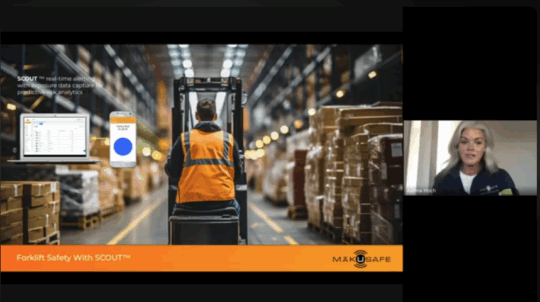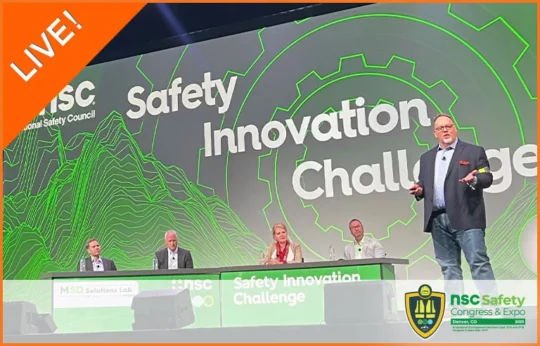Workplace safety’s next horizon: Wearable sensors
June 16, 2017
Serial entrepreneur Gabe Glynn’s fascination with high-
tech factories sparked an idea for a new wearable
safety device that could revolutionize the way
manufacturers approach safety monitoring and
reporting.
His company, MakuSafe, has developed an armband
device that will allow manufacturers to monitor factory
floor safety conditions on a real-time basis and allow
instantaneous reporting of near-miss incidents by
employees.
The idea for a wearable safety monitoring and recording device came to Glynn while he was touring a
manufacturing company a couple of years ago to gather material for an advanced manufacturing blog that
he produces.
The plant was being inspected by federal OSHA representatives because an employee had lost his
hearing. “It was a light-bulb moment for me,” Glynn recalled, realizing the potential if the type of devices
such as the decibel trackers that the employees were wearing could be used all the time to track a variety
of workplace conditions.
“This is an opportunity to change the way manufacturers look at work environments,” Glynn said. “We’re
not gathering that data on an ongoing basis. The environment is organic — it’s constantly changing.”
MākuSafe® is the sixth startup company for the Ankeny resident. He sold his most recent software
business, Slash/Web Studios LLC, in 2015 and used that capital along with personal savings he’s
amassed from other ventures to bootstrap the new company.
The invention has gained the attention of Des Moines-based property and casualty insurer EMC
Insurance Cos., which recently entered into a partnership withMākuSafe® EMC made an initial investment
of $200,000 in the company, with plans to pilot the devices with some of its clients.
“By investing in and partnering with them, we have an opportunity to make workplaces safer, and thereby
reduce insurance losses and claims,” said Scott Jean, executive vice president for finance and analytics
for EMC. Jean said the Global Insurance Accelerator connected them withMākuSafe® “We got talking
about the applicability to insurance, and it became very appealing to pursue a relationship with them,” he
said.
EMC hasn’t yet determined whether it would provide the devices free of charge to clients as a risk
reduction tool, Jean said. “It may make sense for policyholders to have some skin in the game by paying
for the devices,” he said. “For the pilots, we will pay for the devices.”
The insurer is also considering a second investment in MākuSafe® as part of an additional fundraising
round the company is doing, Jean said.
Glynn said his company has raised $1 million toward a $1.25 million fundraising round that it began in
early March. “We raised that locally from angel investors; we really haven’t had to reach outside of
Central Iowa to get that,” he said. That funding will be used to reach a couple of significant product
development milestones in order to receive venture capital funding, he said.
The MākuSafe® device, which a worker attaches to his or her upper arm, senses a variety of
environmental conditions in the manufacturing environment and warns users in real time about unsafe
conditions. Glynn is cautious about saying much about the types of sensors built into the device, to
protect his intellectual property.
“It’s fair to say we were inspired by sound — that was what tripped this whole thing,” he said. “There are
so many other things that affect worker safety, such as heat and air quality issues. We’ve designed the
device to flag those types of things. It’s a variety of things that we’re looking at.”
The device also has a recording button that workers can push to instantly report near-miss incidents
without having to leave the floor or use a cellphone.
“With more consistent reporting, safety managers can better check out hazardous situations and correct
them,” Glynn said. Because workers typically find it inconvenient or view it as unnecessary to report
hazards or near misses, probably 80 to 90 percent of them go unreported.
“On the insurance side, companies like EMC have entire staffs of data scientists and ergonomics experts,
but they don’t have a very strategic way of deploying those assets,” Glynn said. “Now, with this device,
they can deploy those resources much more strategically.”
The U.S. Occupational Safety and Health Administration defines a near miss as “an unplanned event that
did not result in injury, illness, or damage — but had the potential to do so. Only a fortunate break in the
chain of events prevented an injury, fatality or damage.”
To distribute the devices, Glynn has partnered with Ramco Innovations in West Des Moines, which is also
one of the companies testing the devices in an industrial environment.
“It’s a nice match because we’re a distributor for those kinds of products,” said Hank Norem, Ramco’s
president and chief financial officer. The employee-owned company distributes factory automation
components, and has worked with other device makers to establish national distribution networks, Norem
said.
“We have a warehouse and a panel shop where we beta test the devices,” he said. “We have lots of high-
end factory automation devices running, so we can test out how the devices would work in a facility,” he
said.
In addition to testing the devices with a few manufacturers and EMC, MākuSafe® has been contacted by
four other insurance companies that want to work with the company. And it’s already got a backlog of
orders for the devices.
“Currently we have about $5 million in products contracted, so that’s a pretty cool position to be in,” he
said.





